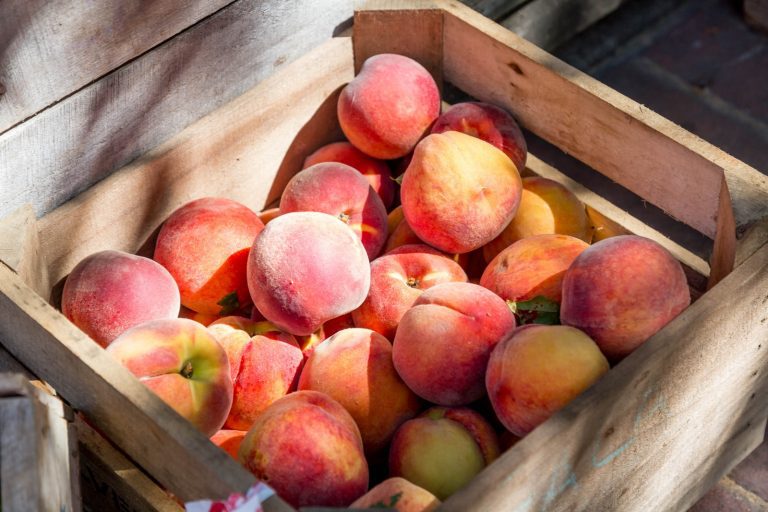Definition and Background
Arugula vs Romaine Lettuce: What are the main differences between arugula and romaine lettuce? Which is better for me? These are questions I receive often as a registered dietitian.
In the quest to follow the United States Dietary Guidelines and meet the daily requirement of vegetables, salad is definitely our friend. A large salad (done right) can check off your veggie requirements for the day in one fell swoop.

For most adults, a healthy diet according to the Dietary Guidelines for Americans, 2020-2025 states that we need 2½ cup-equivalents (cup-eq) of vegetables per day. A cup-eq of vegetables is generally equal to 1 cup of raw or cooked vegetables or vegetable juice, or 2 cups of raw leafy greens.
But not all salad greens are created equal. Leafy greens vary in regard to their nutrient content, nutrient density, flavor, and texture. So it helps to know which salad greens will give you the most bang for the bite and what will taste great in your next salad. Today we are comparing Arugula vs Romaine. What are the main differences? What are the health benefits? How do the different lettuces compare from an appearance, taste, or nutritional profile perspective?
History: Arugula vs Romaine
Arugula
Arugula has a long history, experiencing many peaks and valleys in popularity throughout the centuries and several appearances in famous literature prior to arriving at its current prevalence in modern cuisine. It was even mentioned in the Old Testament Book of Kings (II Kings 4:39, to be exact). So, we know that arugula’s history is a long one and that it was harvested as early as the 6th century B.C.
Known as Eruca vesicaria, Arugula stems from the warmer parts of Europe—namely Italy and along the Mediterranean region, through Turkey, and into western Asia. A member of the mustard family (Brassicaceae), it’s a relative of other common garden plants such as cabbage, broccoli, and kale. Arugula is often found in mesclun seed mixes, as it grows quickly and has a bolder flavor than most greens. Many people love the spicy, peppery taste in salads or as an accompaniment to sandwiches.
Romaine
Lettuce is categorized into two types: head (iceberg) and leaf, which include romaine, butterhead, and leaf types. Lettuce has been grown in the United States since colonial times. In the early 1900s, the ice shipping industry developed in the western states, expanding the range and popularity of lettuce. In terms of annual eating per capita, lettuce salads rank second only to potatoes. Lettuce consumption was nearly the same in the previous three years, but down about 20 percent from ten years ago. (USDA ERS Yearbook Data, 2016) The percent of total consumption of head lettuce and leaf/romaine lettuce derived from imports was 6.9 percent and 5.4 percent, respectively.
Appearance and TasteWhen comparing arugula vs romaine lettuce, you will notice major differences in both appearance and taste.
Arugula
Just like other salad greens, arugula is rich in many important nutrients your body needs to function just right. Read on to learn more about arugula, its nutritional value and health benefits, and some of our favorite arugula recipes.
Appearance
Fresh arugula should be bright and green. Although the leaves are tender, they should not be yellow, wilted or slimy. Store arugula in the refrigerator in a plastic bag with a dry paper towel to absorb excess moisture and prevent decay. Arugula cannot be frozen and is best used within 2 weeks.
Ideally, your arugula leaves should be perky and bright green in color, without yellow discolorations. Some leaves will have pointy ends, while others will be more rounded. If the arugula you see in a store has soggy, wilted leaves, it’s probably past its expiry date.
Taste
The flavor of arugula is peppery, spicy, slightly tart, and a bit nutty. It is a well-liked addition to salad mixtures because of its fresh and bold flavor profile. You can taste the spicy, peppery bite, especially in raw arugula – with soft leaves and a crisp stem, its texture resembles fresh spinach. If you don’t want your arugula to pack a punch in your dishes, cook it – it’s going to have a milder flavor. Keep in mind that the older your arugula gets, the more bitter it will taste, so once you get it, make sure to use it quickly.
Arugula has a mild peppery flavor and adds a bit of zing to salads. Mix it with other greens or use it alone. Add to sandwich layers or chop into cold or hot side dishes. Puree arugula into pesto, dips or spreads. Arugula can also be sautéed or steamed as a stand-alone side dish. It is often used in Italy as a topping for pizza.
RomaineAppearance
Cos (Romaine) lettuce has elongated heads of long leaves with heavy midribs. The outer leaves are coarse and tough in appearance and dark green, but the inner leaves are fine-textured and light green. Use Romaine lettuce as a bread replacement or for use in lettuce wraps because of its unique large, sturdy leaves. The bright green sheaves of lettuce are long and thick, perfect for adding considerable substance to your meals despite being mostly composed of water. Supporting the green leaves are bone-like stalks of white, appropriately referred to as the “ribs” of the lettuce.
Taste
Lettuce isn’t the most overwhelmingly flavorful food; it’s better off as a vessel for other things. However, of the most popular lettuces, romaine is actually known as one of the most flavorful types of lettuce out there! While it does have a bit of a bitter tinge to its taste, you’ll be happy to know that it has a very mild flavor, and the main notes of romaine are crisp and clean. It’s not very sweet, so you don’t have to keep that in mind when pairing it with other ingredients. With sweeter types of lettuce, you have to try and either downplay or accent that sweetness depending on your preferences; romaine lettuce makes for a more neutral ingredient!
Nutritional BenefitsNutritional benefits are plentiful for both arugula and romaine lettuce, but which has the highest nutrient density?
Vitamins and minerals are essential substances that our bodies need to function normally. The known vitamins are vitamins A, C, D, E, and K and the B vitamins: thiamin (B1), riboflavin (B2), niacin (B3), pantothenic acid (B5), pyridoxine (B6), cobalamin (B12), biotin, and folate/folic acid. A number of minerals are essential for health, including calcium, phosphorus, potassium, sodium, chloride, magnesium, iron, zinc, iodine, sulfur, cobalt, copper, fluoride, manganese, and selenium. Below you will see what essential nutrients and nutritional benefits of both arugula and romaine lettuce.
Arugula
Arugula contains multiple antioxidants that fight free radicals known to contribute to aging and disease. These antioxidants include vitamins C and K, beta-carotene, and sulphur–containing compounds called glucosinolates. These compounds are responsible for the tangy flavor of arugula as well as many of its health benefits. Arugula provides several nutrients including:
- Vitamin C
- Beta Carotene
- Vitamin K
- Vitamin A
- Folate
- Calcium
- Potassium
- Magnesium
Arugula is considered a good or excellent source of all these nutrients.
Vitamin C is a water-soluble vitamin. Unlike animals who can make their own vitamin C, humans must consume vitamin C from foods on a daily basis It is required for making collagen for healthy skin and connective tissue, and is important for wound-healing. Vitamin C is involved in protein metabolism, and synthesis of neurotransmitters. Important role in immunity, prevention of scurvy and absorption of non-heme iron.
Beta Carotene is a water-soluble vitamin and it is a type of retinol (precursor to vitamin A) which includes several types of carotenoids. Carotenoids are responsible for the bright colors of our fruits and vegetables. It keeps skin, eyes, and immune system healthy.
Folic Acid makes new cells, DNA, fetus brain development
Vitamin K is a fat-soluble vitamin and is involved in blood-clotting, bone metabolism and antioxidation. It includes sulfur-containing compounds found in Brassica (Cruciferous) vegetables. Chewing or chopping arugula greens triggers antioxidant and anti-inflammatory responses that can reduce risk of disease. One form of glucosinolate is sulphoraphane. Studies demonstrate this compound can detoxify carcinogens and inhibit cancer cell growth. Studies found beneficial effects of cruciferous vegetables like arugula for reducing risk of breast, bladder, colorectal, endometrial, gastric, lung, ovarian, pancreatic, prostate and renal cancer
Minerals
Calcium Calcium is important for bone health throughout your life. Your body needs calcium to build and maintain strong bones. Your heart, muscles, and nerves also need calcium to function properly.
Many people think that because romaine lettuce is so low in calories, it must also be low in nutrients. That couldn’t be further from the truth. In fact, romaine lettuce provides several important nutrients:
- Vitamin K
- Vitamin A
- Folate
Romaine lettuce is considered a good or excellent source of all these nutrients.
Vitamin K Romaine lettuce is an excellent source of vitamin K, providing about 40% of your recommended Daily Value of this nutrient per cup.Vitamin K is an important, but underappreciated nutrient. It’s vitamin D’s silent partner in utilizing calcium to build bones. Even in relatively small doses, vitamin K1, the type found in romaine lettuce, can work with vitamin D to help people with osteoporosis to add bone mass and reduce their risk of fractures.
Vitamin K also helps the body produce proteins necessary for proper blood clotting. This helps you avoid serious bleeding if you are cut.
Vitamin A Vitamin A is a powerful antioxidant that can support heart health and reduce your risk of some types of cancer. A cup of romaine lettuce provides about 20% of the vitamin A your body needs daily. Vitamin A is especially important for eye health. It can help reduce your risk of night blindness, cataracts, and age-related macular degeneration (AMD).
Romaine lettuce supplies vitamin A as beta-carotene. This isn’t actually active vitamin A. If you take in too much vitamin A from supplements, you might experience negative effects, but with beta carotene, your body can make the vitamin A it needs without ever getting too much.
Folate Romaine is a good source of folate. A one-cup portion of romaine lettuce supplies 16% of your recommended daily value of folate. Folate is an essential nutrient for healthy pregnancy. Folate is a B vitamin that lowers the risk of birth defects in a baby’s brain and spine. It also helps the body produce red blood cells to reduce the risk of anemia.
Weight Loss
Because of the high water content and to support your weight loss goals, add leafy greens to your plate as often as possible.
Arugula
The inclusion of arugula in a diet is the same as any other low-calorie, vitamin or nutrient-rich plant; and it will inevitably have a positive effect on attempts at weight loss. By satisfying so many nutritional needs with calorie-density food, it is an easy way to watch your health and keep your system balanced, without making drastic changes to your diet.
RomaineRomaine lettuce is suitable for people who wish to lose weight, due to its high nutrient density and low calorie content. However, it can be a tasty and healthful addition to any meal and eating plan. The nutrients and minerals it contains can provide benefits to anyone who regularly eats it.
Big-leafed greens like lettuce or romaine lettuce are great substitutions for bread or wraps. You can fill these greens with toppings like meat or veggies. The leaf can also be used as a wrap, to hold everything together. Lettuce wraps are extremely fresh and way lower in calories than bread-based wraps
Common Pairings and Easy Recipes
Arugula
COMMON PAIRINGS
Arugula is commonly paired with salty ingredients like olives, thinly sliced sardines, or prosciutto. You can toss in zesty pickled onions, beets, or radishes (which can all lend brightness both in flavor and color). Or you can add in some roasted red peppers or sun-dried tomatoes for a touch of sweetness and round out the flavors.
EASY RECIPES
You can also try the easy recipes with arugula below:
Arugula and Roasted Tomato Salad
You can create a classic Italian arugula salad that is very simple that it really requires no measurements: a bowl of peppery arugula, a bright squeeze of lemon, a few swirls of extra-virgin olive oil, nutty Parmigiano Reggiano shavings, salt, and pepper. Because there are so few ingredients as with most Italian recipes, for the best flavor, it is extremely important that you use very fresh and high-quality ingredients. Serve the salad as a first course or with grilled steak, grilled chicken, or a thin-crust pizza.
Romaine
COMMON PAIRINGS
Romaine lettuce pairs well with bulgur wheat, parsley, garlic, chives, tomatoes, roasted red pepper, citrus, avocado, apples, pears, black olives, capers, grilled steak, poultry, bacon, tuna, smoked fish, feta cheese, blue cheese, parmesan cheese, and hummus.
EASY RECIPES
You can also try the easy recipes with romaine lettuce below:
Caesar Salad RecipeGrocery Stores – How to Buy and How to Store
Arugula
HOW TO BUY
Choose bright, dry, fresh-looking arugula with a peppery, clean scent and no signs of wilting. Pre-washed, bagged arugula is also available at supermarkets.
HOW TO STORE
Arugula is very perishable. Do not rinse until right before ready to use. Store tightly wrapped in a plastic bag in the refrigerator for up to 2 days.
RomaineHOW TO BUY
Look for dark green outer leaves that are closely bunched, firm, and crisp-looking. Go for bright green leaves and try to avoid those with browning on the white ribs of the romaine. As with many leafy greens, handle gently to avoid marks on the leaves. Romaine lettuce has sturdier leaves than other leafy greens, like spinach, so this should be rare.
HOW TO STORE
When you get home from the store, start by removing the romaine from its packaging and discard any damaged outer leaves. Next, wrap the heads in paper towels, and place them in fresh plastic bags in your refrigerator’s crisper drawer.
Lettuce Varieties and Alternates
Arugula Alternatives
- Baby Arugula
- Spring Mix
- Watercress
- Endive
- Broccoli Rabe
Romaine Alternatives
- Belgian Endive
- Butterhead Lettuce
- Oak Leaf Lettuce
- Radicchio
- Rainbow Chard
- Lacinato Kale






